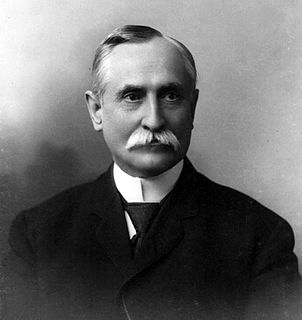Related Research Articles

Phineas Parkhurst Quimby was an American clockmaker, mentalist and mesmerist. His work is widely recognized as foundational to the New Thought spiritual movement.

Mary Baker Eddy was an American religious leader and author who founded The Church of Christ, Scientist, in New England in 1879. She also founded The Christian Science Monitor, a Pulitzer Prize-winning secular newspaper, in 1908 and three religious magazines: the Christian Science Sentinel, The Christian Science Journal, and The Herald of Christian Science. She wrote numerous books and articles, the most notable of which was Science and Health with Key to the Scriptures, which had sold over nine million copies as of 2001.

Christian Science is a set of beliefs and practices belonging to the metaphysical family of new religious movements. It was founded in 19th-century New England by Mary Baker Eddy, who argued in her 1875 book Science and Health with Key to the Scriptures that sickness is an illusion that can be corrected by prayer alone. The book became Christian Science's central text, along with the Bible, and by 2001 had sold over nine million copies.

The Destiny of The Mother Church is a book by Bliss Knapp published by Christian Science Publishing Society in 1991. Knapp and his parents, Ira O. and Flavia Stickney Knapp, all knew Mary Baker Eddy. His parents were students of hers and his father was one of the original members of the Board of Directors of The Mother Church. Until 1991, the book was repeatedly rejected for publication by the Christian Science Board of Directors because of the depiction of Eddy as the fulfillment of biblical prophecy and equating her with Christ Jesus, a position which Eddy considered blasphemous. Eddy identified the woman in the Book of Revelation not as a person, but as "generic man". Destiny's publication caused divisions within the church, including several resignations of prominent church employees. Critics claimed that the failure of the church's then-recent television venture, which had cost the church several hundred million dollars, had motivated the Board's reversal on publishing Knapp's book. Knapp, his wife and her sister left wills that granted bequests totalling over $100 million promised to the church if the book were to be published. The wills set a time limit of 20 years for the book to be published, otherwise the bequests were to be divided between Stanford University and the Los Angeles County Museum of Art, and the church would receive nothing. The 1973 death of Knapp's wife set the date of the time limit to May 1993.

Bliss Knapp, the son of Ira O. and Flavia S. Knapp, students of Mary Baker Eddy, was an early Christian Science lecturer, practitioner, teacher and the author of The Destiny of the Mother Church.
A Christian Science practitioner is an individual who prays for others according to the teachings of Christian Science. Treatment is non-medical, rather it is based on the Bible and the Christian Science textbook, Science and Health with Key to the Scriptures (1875) by Mary Baker Eddy (1821–1910), who said she discovered Christian Science in 1866 and founded the Christian Science church in 1879. According to the church, Christian Science practitioners address physical conditions, as well as relationship or financial difficulties and any other problem or crisis. Despite the non-medical nature of their practice, Christian Science practitioners were aggressively prosecuted in the late 19th century by newly established state medical societies across the United States. Most state courts dismissed these actions because the courts ruled that they did not practice medicine. Practitioners are either "listed" or "unlisted," a designation that refers to a form of international accreditation maintained by The Mother Church, in Boston, Massachusetts. "Listed" practitioners are included in the directory of Christian Science practitioners on the church website, and printed in the Christian Science Journal.

The Church Manual of The First Church of Christ, Scientist, in Boston, Massachusetts commonly known as the Manual of The Mother Church is the book that establishes the structure and governs the The First Church of Christ, Scientist, also known as The Mother Church, functioning like a constitution. It was written by Mary Baker Eddy, founder of the church. It was first published in 1895 and was revised dozens of times. The final edition, the 89th, was published in 1910.
Robert Arthur Peel was a Christian Science historian and writer on religious and ecumenical topics. A Christian Scientist for over 70 years, Peel wrote editorials for the Christian Science Monitor, a publication owned by the Church of Christ, Scientist. He was also a counsellor for the church's Committee on Publication, set up by Mary Baker Eddy (1821–1910), the religion's founder, to protect her own and the church's reputation.

Emma Curtis Hopkins was an American spiritual teacher and leader. She was involved in organizing the New Thought movement and was a primary theologian, teacher, writer, feminist, mystic, and healer, who ordained hundreds of people, including women, at what she named the Christian Science Theological Seminary of Chicago. Emma Curtis Hopkins was called the "teacher of teachers" because a number of her students went on to found their own churches or to become prominent in the New Thought Movement.

Septimus James Hanna, an American Civil War veteran and a judge in the Old West. He was a student of Mary Baker Eddy, who founded the Christian Science church. Giving up his legal career, he became a Christian Science practitioner, lecturer and teacher. Hanna occupied more leading positions within the church organization than any individual, serving as pastor, then First Reader of The Mother Church, as editor and associate editor of the periodicals, member of the Bible Lesson Committee, he served two terms as president of The Mother Church, he was teacher of the Normal (teachers) Class of 1907, later vice president and then president of the Massachusetts Metaphysical College.

Augusta Emma Stetson was an American religious leader. Known for her impressive oratory skills and magnetic personality, she attracted a large following in New York City. However, her increasingly radical theories, conflicts with other church members including a well-known rivalry with Laura Lathrop, and attempts to supplant Mary Baker Eddy as the leader of The First Church of Christ, Scientist, led to her eventually being excommunicated from the church on charges of insubordination and of false teaching. Afterwards she began preaching and publishing various works on her theories which she named the "Church Triumphant," and started a controversial radio station to advance her cause.

The Salem witchcraft trial of 1878, also known as the Ipswich witchcraft trial and the second Salem witch trial, was an American civil case held in May 1878 in Salem, Massachusetts, in which Lucretia L. S. Brown, an adherent of the Christian Science religion, accused fellow Christian Scientist Daniel H. Spofford of attempting to harm her through his "mesmeric" mental powers. By 1918, it was considered the last witchcraft trial held in the United States. The case garnered significant attention for its startling claims and the fact that it took place in Salem, the scene of the 1692 Salem witch trials. The judge dismissed the case.

The Life of Mary Baker G. Eddy and the History of Christian Science (1909) is a highly critical account of the life of Mary Baker Eddy, the founder of Christian Science, and the early history of the Christian Science church in 19th-century New England. It was published as a book in November 1909 in New York by Doubleday, Page & Company. The original byline was that of a journalist, Georgine Milmine, but a 1993 printing of the book declared that novelist Willa Cather was the principal author; however, this assessment has been questioned by more recent scholarship which again identifies Milmine as the primary author, although Cather and others did significant editing. Cather herself usually wrote that she did nothing more than standard copy-editing, but sometimes that she was the primary author.

Rev. Irving Clinton Tomlinson was an American Universalist minister who converted to Christian Science, becoming a practitioner and teacher. For a time, he lived as one of the workers in the household of church founder, Mary Baker Eddy, later writing a book about his experiences called Twelve Years with Mary Baker Eddy.
Annie M. Knott was an early student of Mary Baker Eddy and became a Christian Science practitioner and teacher. She first turned to Christian Science in an emergency involving her toddler son, afterward taking up the study of the religion and devoting her life to it. She later became a member of the Bible Lesson Committee and was the first woman to become a member of the Christian Science Board of Directors.

Calvin Augustine Frye was the personal assistant of Mary Baker Eddy (1821–1910), the founder of Christian Science.

John Valentine Dittemore was director of The First Church of Christ, Scientist, the Christian Science church, in Boston from 1909 until 1919. Before that he was head of the church's Committee on Publication in New York, and a trustee for ten years of the estate of Mary Baker Eddy (1821–1910), the founder of the church. Dittemore is best known as the co-author, with Ernest Sutherland Bates, of Mary Baker Eddy: The Truth and the Tradition (1932).
Edwin Franden Dakin was an American advertising executive and author.

Sibyl Wilbur O'Brien Stone, best known as Sibyl Wilbur, was an American journalist, suffragist, and author of a biography of Mary Baker Eddy. She was a San Diego Branch Member of the National League of American Pen Women and a member of the New England Woman's Press Association.

Adam Herbert Dickey, was an author, member of the Board of Directors of The First Church of Christ, Scientist, and a secretary to Mary Baker Eddy.
References
- ↑ "Samuel Putnam Bancroft". Find a Grave. Retrieved 10 March 2020.
- ↑ Peel, Robert (1971). Mary Baker Eddy: The Years of Trial . New York: Holt, Rinehart and Winston. p. 10.
- 1 2 Kennedy, Hugh A. Studdert. (1931). Mrs. Eddy as I Knew Her: Being Some Contemporary Portraits of Mary Baker Eddy, the Discoverer and Founder of Christian Science. The Farallon Press. pp. 168-172
- ↑ Bates, Ernest Sutherland; Dittemore, John Valentine. (1932). Mary Baker Eddy: The Truth and the Tradition. A. A. Knopf. p. 139
- ↑ Eddy, Mary Baker. (1913). The First Church of Christ, Scientist, and Miscellany. Boston. p. 60
- ↑ Tucker, Ruth A. (1989). Another Gospel: Cults, Alternative Religions, and the New Age Movement. Zondervan. p. 158. ISBN 0-310-25937-1
- ↑ Schoepflin, Rennie B. (2003). Christian Science on Trial: Religious Healing in America. Johns Hopkins University Press. p. 49. ISBN 0-8018-7057-7
- ↑ Wilbur, Sibyl. (1908). The Life of Mary Baker Eddy. Concord Publishing Co. p. 202
- ↑ Peel, Robert (1971). Mary Baker Eddy: The Years of Trial . New York: Holt, Rinehart and Winston. p. 17.
- ↑ Warneck, Robert (2009). Christian Healer (Amplified ed.). CSPS. pp. 419–420.
- 1 2 Peel, Robert (1971). Mary Baker Eddy: The Years of Trial . New York: Holt, Rinehart and Winston. p. 123.
- ↑ James, Edward T; James, Janet Wilson; Boyer, Paul S. (1971). Notable American Women, 1607–1950: A Biographical Dictionary, Volume 1. Harvard University Press. p. 561. ISBN 978-0674627345
- ↑ "Mrs. Eddy As I Knew Her In 1870". The Bookmark. Retrieved 10 March 2020.
- ↑ Bates and Dittemore, 1932. p. 4
- ↑ Larson, Martin Aldred. (1985). New Thought Or a Modern Religious Approach. Philosophical Library. p. 149
- ↑ "Samuel Putnam Bancroft". Mary Baker Eddy Papers. Mary Baker Eddy Library. Retrieved 10 March 2020.